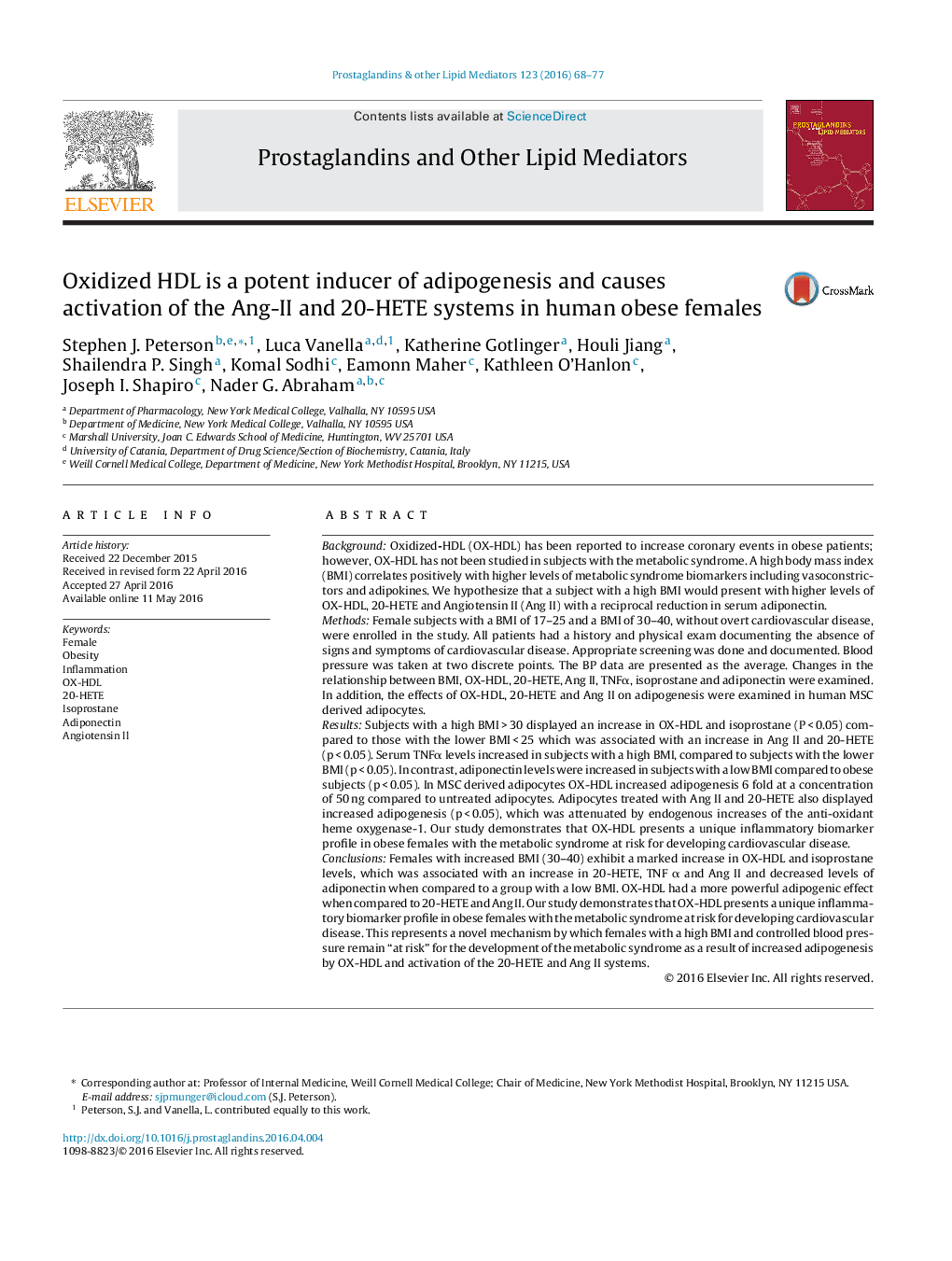| کد مقاله | کد نشریه | سال انتشار | مقاله انگلیسی | نسخه تمام متن |
|---|---|---|---|---|
| 2019462 | 1542209 | 2016 | 10 صفحه PDF | دانلود رایگان |

BackgroundOxidized-HDL (OX-HDL) has been reported to increase coronary events in obese patients; however, OX-HDL has not been studied in subjects with the metabolic syndrome. A high body mass index (BMI) correlates positively with higher levels of metabolic syndrome biomarkers including vasoconstrictors and adipokines. We hypothesize that a subject with a high BMI would present with higher levels of OX-HDL, 20-HETE and Angiotensin II (Ang II) with a reciprocal reduction in serum adiponectin.MethodsFemale subjects with a BMI of 17–25 and a BMI of 30–40, without overt cardiovascular disease, were enrolled in the study. All patients had a history and physical exam documenting the absence of signs and symptoms of cardiovascular disease. Appropriate screening was done and documented. Blood pressure was taken at two discrete points. The BP data are presented as the average. Changes in the relationship between BMI, OX-HDL, 20-HETE, Ang II, TNFα, isoprostane and adiponectin were examined. In addition, the effects of OX-HDL, 20-HETE and Ang II on adipogenesis were examined in human MSC derived adipocytes.ResultsSubjects with a high BMI > 30 displayed an increase in OX-HDL and isoprostane (P < 0.05) compared to those with the lower BMI < 25 which was associated with an increase in Ang II and 20-HETE (p < 0.05). Serum TNFα levels increased in subjects with a high BMI, compared to subjects with the lower BMI (p < 0.05). In contrast, adiponectin levels were increased in subjects with a low BMI compared to obese subjects (p < 0.05). In MSC derived adipocytes OX-HDL increased adipogenesis 6 fold at a concentration of 50 ng compared to untreated adipocytes. Adipocytes treated with Ang II and 20-HETE also displayed increased adipogenesis (p < 0.05), which was attenuated by endogenous increases of the anti-oxidant heme oxygenase-1. Our study demonstrates that OX-HDL presents a unique inflammatory biomarker profile in obese females with the metabolic syndrome at risk for developing cardiovascular disease.ConclusionsFemales with increased BMI (30–40) exhibit a marked increase in OX-HDL and isoprostane levels, which was associated with an increase in 20-HETE, TNF α and Ang II and decreased levels of adiponectin when compared to a group with a low BMI. OX-HDL had a more powerful adipogenic effect when compared to 20-HETE and Ang II. Our study demonstrates that OX-HDL presents a unique inflammatory biomarker profile in obese females with the metabolic syndrome at risk for developing cardiovascular disease. This represents a novel mechanism by which females with a high BMI and controlled blood pressure remain “at risk” for the development of the metabolic syndrome as a result of increased adipogenesis by OX-HDL and activation of the 20-HETE and Ang II systems.
Journal: Prostaglandins & Other Lipid Mediators - Volume 123, March 2016, Pages 68–77